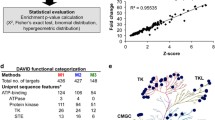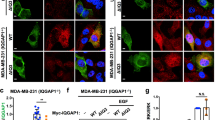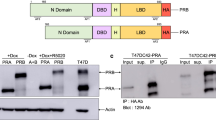Abstract
In previous studies, involving molecular modeling of wild-type and oncogenic forms of the ras-p21 protein bound to GTPase activating protein GAP and the ras-specific guanine nucleotide exchange-promoting protein, SOS, we identified specific domains of GAP and SOS proteins that differ in conformation when the computed average structures of the corresponding wild-type and oncogenic complexes are superimposed. Additionally, in these previous studies, we have synthesized peptides corresponding to these domains and found that all of them inhibit either or both oncogenic (Val 12-containing) p21- and insulin-activated wild-type p21-induced oocyte maturation. To document further the specificity of the inhibition of these peptides for the ras signal transduction pathway, we have now tested their effects on progesterone-induced maturation that occurs by a ras-independent pathway. None of these peptides, including a peptide corresponding to residues 980–989 of SOS that completely blocks oncogenic p21-induced maturation and also causes extensive inhibition of insulin-induced maturation, affects progesterone-induced maturation, suggesting that all of these peptides are specific for the ras pathway. Since our approach to the design of peptides that can inhibit oncogenic ras-p21 selectively is based on identifying domains that differ in conformation between oncogenic and wild-type complexes, we have now further synthesized peptides that correspond to domains of GAP (residues 903–910) and SOS (residues 792–804) that do not differ in conformation when the average structures are superimposed. These peptides do not inhibit either oncogenic p21- or insulin-induced oocyte maturation, supporting the overall strategy of using peptides from domains that change conformation as the ones most likely to inhibit oncogenic and/or wild-type ras-p21. These results further support the specificity of inhibition of the GAP and SOS peptides from the conformationally distinct domains of both proteins.
Similar content being viewed by others
Abbreviations
- GAP:
-
GTPase activating protein
- MAPK:
-
mitogen-activated protein kinase, also called ERK
- RBD:
-
ras-binding domain of raf
- SOS:
-
guanine nucleotide exchange-promoting protein, also referred to as “son-of-sevenless” (SOS) in Drosophila
References
V. Adler M. R. Pincus P. W. Brandt-Rauf Z. Ronai (1995) Proc. Natl. Acad. Sci. USA 92 10585–10589 Occurrence Handle7479845
V. Adler M. R. Pincus A. Polatskaya X. Montano F. K. Friedman Z. Ronai (1996) J. Biol. Chem. 271 23304–23309 Occurrence Handle10.1074/jbc.271.51.32491 Occurrence Handle8798530
C. Birchmeier D. Broek M. Wigler (1985) Cell 43 615–621 Occurrence Handle10.1016/0092-8674(85)90233-8 Occurrence Handle2416466
J. M. Chen F. K. Friedman M. J. Hyde R. Monaco M. R. Pincus (2000) J. Protein Chem. 18 867–874 Occurrence Handle10.1023/A:1020631313180
J. M. Chen F. K. Friedman P. W. Brandt-Rauf M. R. Pincus (2002) J. Protein Chem. 21 349–359 Occurrence Handle10.1023/A:1019994302273 Occurrence Handle12206509
L. Chie F. K. Friedman T. Duncan J. M. Chen D. L. Chung M. R. Pincus (2004) Protein J. 23 229–234 Occurrence Handle10.1023/B:JOPC.0000026418.82786.5e Occurrence Handle15200054
D. L. Chung A. Joran F. K. Friedman R. R. Robinson P. W. Brandt-Rauf I. B. Weinstein Z. A. Ronai L. Baskin D. C. Dykes R. B. Murphy S. Nishimura Z. Yamaizumi M. R. Pincus (1992) Exp. Cell Res. 203 329–335 Occurrence Handle10.1016/0014-4827(92)90006-T Occurrence Handle1459198
G. J. Clark J. K. Westwick C. J. Der (1997) J. Biol. Chem. 272 1677–1681 Occurrence Handle10.1074/jbc.272.3.1677 Occurrence Handle8999845
A. K. Deshpande H.-F. Kung (1987) Mol. Cell Biol. 7 1285–1288 Occurrence Handle3550436
T. Duncan J. M. Chen F. K. Friedman M. Hyde M. R. Pincus (2004) Protein J. 23 217–228 Occurrence Handle10.1023/B:JOPC.0000026417.72621.1f Occurrence Handle15200053
F. K. Friedman L. Chie D. L. Chung R. Robinson P. W. Brandt-Rauf Z. Yamaizumi M. R. Pincus (2002) J. Protein Chem. 21 361–366 Occurrence Handle10.1023/A:1019946419111 Occurrence Handle12206510
A. Glozman S. Amar D. Chung V. Adler Z. Ronai P. W. Brandt-Rauf S. Nishimura Z. Yamaizumi M. R. Pincus (1996) Med. Sci. Res. 24 331–333
M. Kanovsky J. Michl G. Botzolaki J. Morin C. Kovac D. Chung F. K. Friedman M. R. Pincus (2003) Cancer Chemother. Pharmacol. 52 202–208 Occurrence Handle10.1007/s00280-003-0639-3 Occurrence Handle12783204
K. Miura Y. Inouye H. Nakamori S. Iwai E. Ohtsuka M. Ikehara S. Noguchi S. Nishimura (1986) Jpn. J. Cancer Res. (Gann) 77 45–51
M. R. Pincus (2004) Front. Biosci. 9 3486–3509 Occurrence Handle15353372
J.-Y. Yang C. Widmann (2001) Mol. Cell Biol. 21 5346–5358 Occurrence Handle10.1128/MCB.21.16.5346-5358.2001 Occurrence Handle11463818
Author information
Authors and Affiliations
Corresponding author
Rights and permissions
About this article
Cite this article
Chie, L., Chung, D. & Pincus, M.R. Specificity of Inhibition of ras-p21 Signal Transduction by Peptides from GTPase Activating Protein (GAP) and the Son-of Sevenless (SOS) ras-Specific Guanine Nucleotide Exchange Protein. Protein J 24, 253–258 (2005). https://doi.org/10.1007/s10930-005-6723-2
Issue Date:
DOI: https://doi.org/10.1007/s10930-005-6723-2




